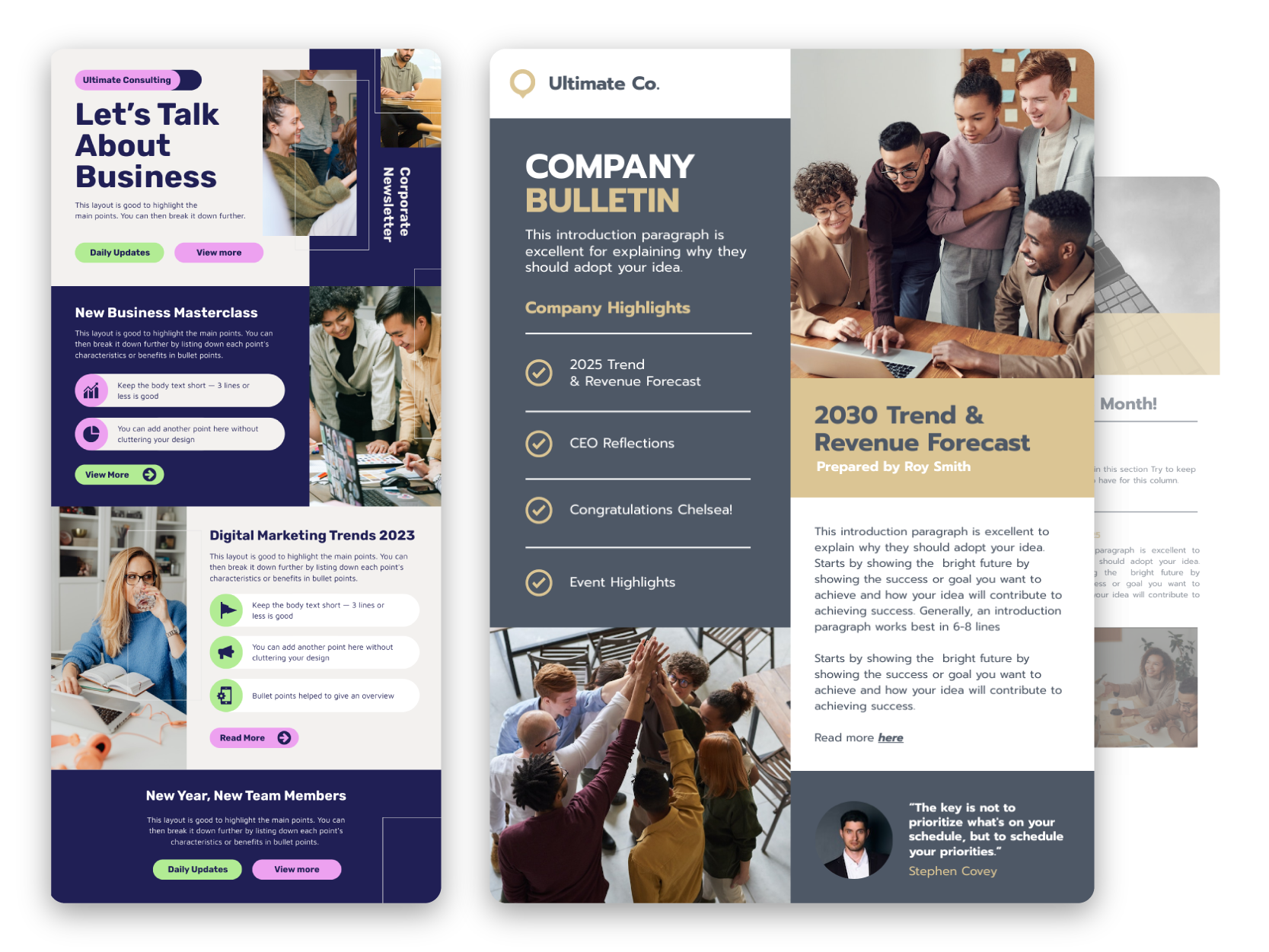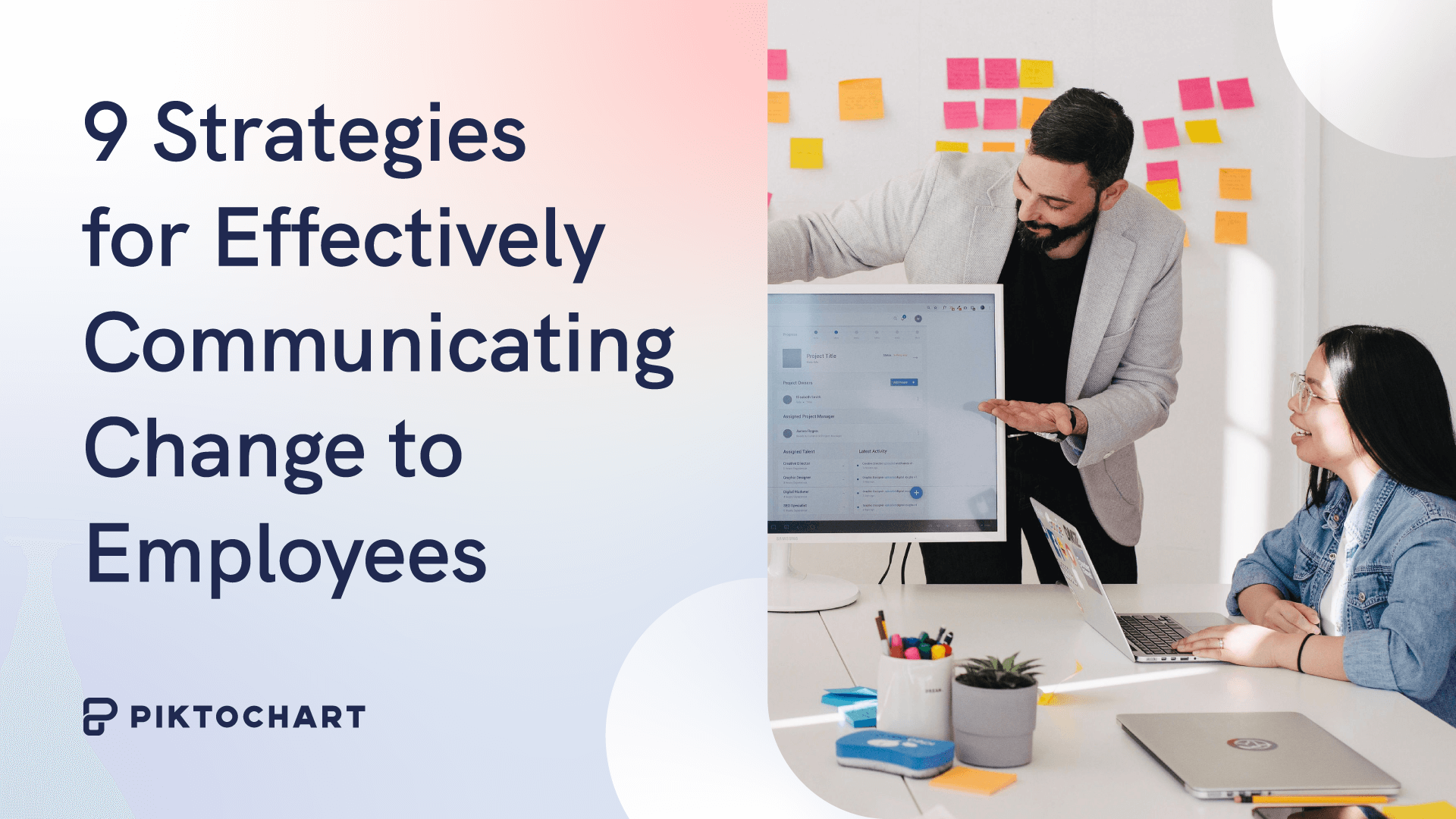Like a ship’s captain relies on a motivated crew for a successful journey, your company needs engaged employees to thrive. A well-crafted employee engagement plan is your compass to guide the way.
Coming up with your own employee engagement strategy can be tough. This plan, built on solid data and tested methods, helps you unlock your team’s potential and align their efforts with your company’s goals. We’ll walk you through six key steps to create a workplace where employees feel valued and perform at their best.
In this guide, you’ll learn how to boost job satisfaction, increase productivity, and keep your team committed for the long haul. The journey to a more engaged workforce starts here. Let’s lay down a strong foundation together and take your company to new heights.
Key Takeaways
- Prioritize Authenticity in Communication: The cornerstone of any engagement plan is genuine, transparent communication. Avoid corporate speak; instead, opt for honest, relatable dialogue that resonates with employees at all levels.
- Focus on Emotional Connection: Engagement is more than just job satisfaction. It’s about creating an emotional bond between employees and the company. Highlight stories and initiatives that foster a sense of belonging and purpose.
- Customize to Your Culture: One size doesn’t fit all. Tailor your engagement strategies to align with your unique company culture and values. What works for a tech startup might not suit a traditional manufacturing firm.
- Leadership Involvement is Key: Successful engagement plans require more than just HR’s involvement; they need visible commitment and participation from top leadership. When leaders model engagement, it sets a powerful example.
- Avoid Over-Engineering: A common pitfall is creating overly complex plans. Simplicity is often more effective. Choose a few impactful strategies and execute them well, rather than a multitude of initiatives that become challenging to manage and track.
What Is an Employee Engagement Plan?
An employee engagement plan is a way to help workers feel more connected and motivated about their jobs and the company.
To make a good plan, you need to know what makes your workers happy. Only from there can you build a program just for them. There are many ways to encourage employees, such as different ways of saying ‘thank you’ or giving chances for them to learn and grow in their careers in personalized ways.
It’s also key to check in on how the plan is working. You can ask workers how they feel, talk with them one-on-one, or have group chats. The information you get from these talks will guide your plan and show you where to make it even better.
Why It’s Important To Use an Employee Engagement Plan
Creating an employee engagement plan is a smart move for anyone focused on improving the way a company works. Here’s why having this plan is a game-changer:
- Provides a Clear Roadmap: A well-defined engagement plan gives you a clear roadmap to follow. It helps you understand what steps to take and when to take them. This makes your job easier because you have a structured approach to increasing engagement, rather than just guessing what might work.
- Helps Measure Progress: With a plan, you can set specific goals and track your progress towards them. This is really helpful because it lets you see what’s working and what’s not. You can use this information to make smart decisions and show others in the company the real impact of your efforts.
- Increases Consistency: An engagement plan ensures that efforts to boost engagement are consistent across the company. This means that all employees, no matter their department or location, get to experience the same level of engagement efforts. It prevents some teams from feeling left out and helps maintain a unified company culture.
- Saves Time and Resources: Having a plan saves time and resources in the long run. Instead of trying random activities or initiatives, you spend your energy on strategies that are part of a bigger, well-thought-out plan. This approach is more efficient and can lead to better results with less effort.
- Enhances Communication: A key part of any engagement plan is communication. By creating this plan, you improve the way you communicate with employees. It helps ensure that everyone understands the company’s goals, their role in achieving them, and how they can benefit from being more engaged.
An engagement plan isn’t just a nice-to-have; it’s a must-have for any company looking to seriously improve how it operates. It’s your blueprint for creating a more engaged, productive, and happy team.
How to Create an Employee Engagement Plan in 6 Steps
Ever tried one thing to make everyone happy and it just didn’t work? That’s a common mistake in making an effective employee engagement strategy. Just like in a sport team, every player needs something different to do their best.
Think about it like making a special playlist for a road trip with friends. You pick songs everyone likes so the whole trip is fun. That’s what we’re doing here. Here are six steps to create an effective employee engagement plan and start improving employee engagement.
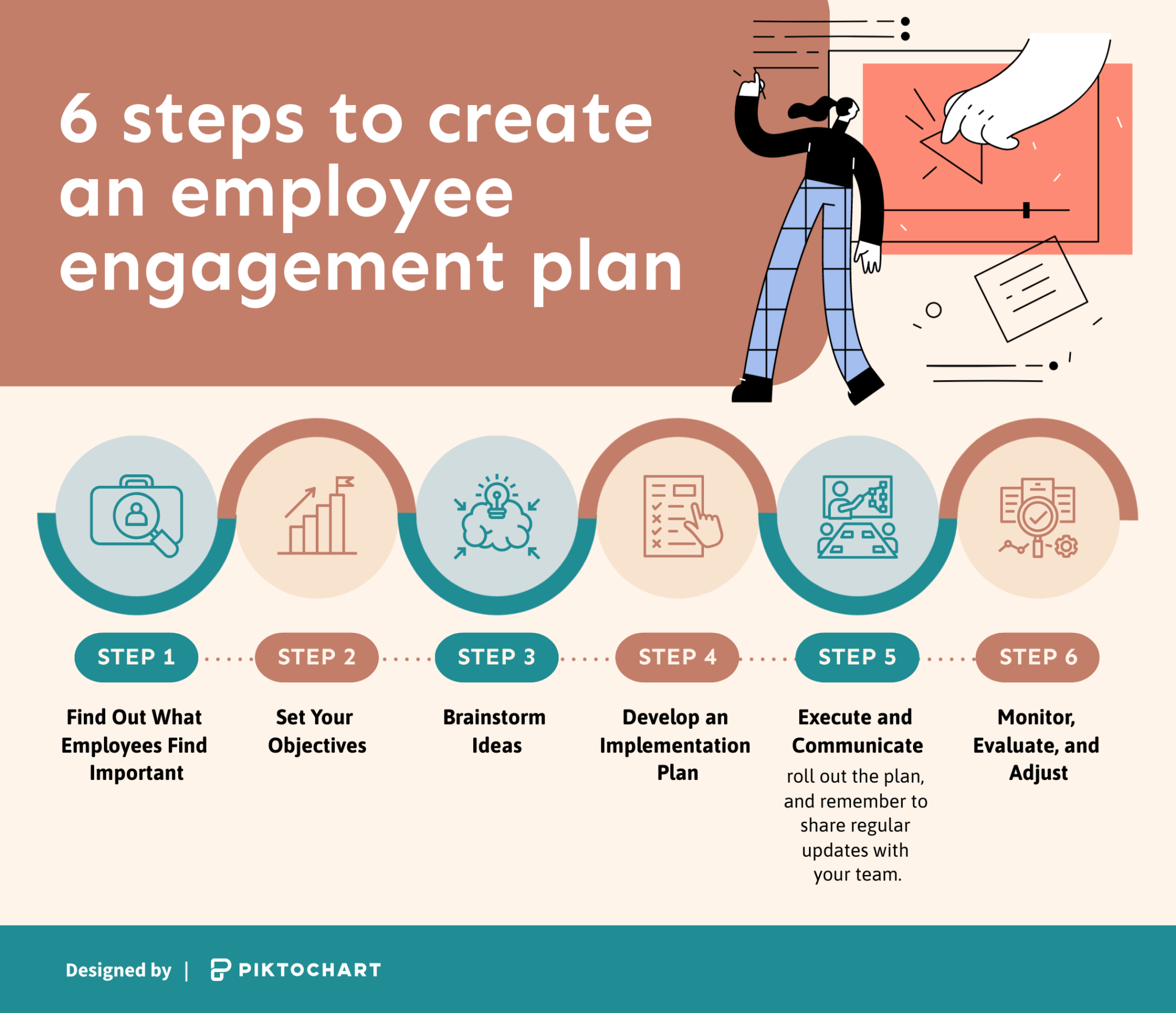
Step 1: Find Out What Employees Find Important
Before you can create a successful employee engagement strategy, you first need to understand what your employees want. You could just craft a plan based on previous information, but the old data is most likely going to be outdated. It’s crucial to gather employee feedback and really know your team to find out what makes them happy and productive at work.
Consider this your data-gathering and research phase. Start with an employee engagement survey to get an overview of employee morale and motivation. This can be your new baseline before you create an employee engagement plan.
Pay careful attention to feedback to see any common themes popping up in terms of what people enjoy about their work and what they need to have a good balance between work and life. This will help you measure how happy your employees are and figure out what parts of your work environment are working well and what parts need to be better.
Step 2: Set Your Objectives
You’ve got your data – now it’s time to set your goals and how you will measure employee engagement.
These goals should match the bigger aims of your company and you should be able to check on progress with clear markers, like KPIs. Think about what a win looks like for you. Is it seeing fewer people leave, having your team do more, or coming up with fresh ideas?
Let’s say making a friendly workplace is key for your company’s culture. Then, one goal might be to start a program that gives a shout-out to employees for their big wins and important moments.
Try not to set more than two objectives. This makes your plan more likely to succeed when you’re aiming to achieve specific outcomes.
From the surveys, identify which areas you want to improve on, such as:
- Level of job satisfaction
- Meaningful work
- Work environment
- Career advancement opportunities
- Flexible work schedules
- Company culture
Step 3: Brainstorm Ideas
With your objectives set, it’s time to brainstorm ideas for your employee engagement plan.
You can think of ideas by yourself, but you’ll probably find a brainstorming session with your team will yield better results. Encourage everyone to share their thoughts, no matter how out-of-the-box they seem. Remember, the best ideas often come from those who experience the day-to-day work life in your company.
For example, if career advancement is an area to improve, consider setting up mentorship programs or regular career development workshops. If job satisfaction is a focus, think about introducing more team-building activities or creating a ‘kudos’ board where employees can celebrate each other’s achievements.
Although this is just the early stages, you can also explore how technology can aid your plan. Maybe there’s a new learning management system you can sign up for different teams or a platform where employees can access professional development resources.
At the end of this brainstorming session, you should have a list of potential initiatives. Next, you’ll need to evaluate these ideas, considering factors like impact, feasibility, and alignment with your objectives and company culture. This will help you narrow down to the most effective strategies for your engagement plan.
Keep in mind, each idea should link back to your objectives and be practical. It’s great to dream big, but you also need to think about what’s achievable with the resources you have.
Step 4: Develop an Implementation Plan
Once you have a list of potential initiatives, it’s time to create a detailed implementation plan. This should include who will be responsible for each part of the plan, timelines for execution, and resources required.
For example, if one of your initiatives is to set up mentorship programs, determine who will oversee the program, how mentors and mentees will be paired, and a timeline for the program’s rollout.
After brainstorming, it’s time to lay out your action plan. Here’s how to do it: Take each idea you chose and break it down into steps. Say you’re setting up a mentorship program. First, decide who will run it. Then, work out how to pair mentors with mentees.
Maybe you can match them based on interests or career goals. Set a clear timeline – when will the program start and how long will it run? Also, think about resources. Do you need a budget for training materials or for organizing meet-ups?
Step 5: Execute and Communicate
All the pieces are in place; it’s time to roll out your plan. And while you’re focused on monitoring the results to see if the plan will improve employee engagement, remember to update the company what’s happening during this phase. Keep your team informed about what’s happening, why it’s happening, and how they can be involved.
Regular updates on the progress of the initiatives can maintain enthusiasm and participation. For instance, if you’re rolling out new team-building activities, communicate the schedule, objectives, and expected outcomes to your team.
Say you’re starting new team-building activities. Tell your team when and why these activities are happening. Maybe send a calendar invite with a fun message or a teaser of what’s to come. Keep the updates coming.
If you’re two months into the mentorship program, share a story or two about how it’s helping. These updates make people feel part of something bigger and keep the excitement alive.
Step 6: Monitor, Evaluate, and Adjust
Last but not least, you’ll want to monitor the effectiveness of your engagement initiatives. Use the KPIs and markers you set in step two to measure progress. Collect feedback from employees to gauge the impact of the initiatives on their engagement levels. Be prepared to make adjustments based on this feedback.
For example, if a particular initiative isn’t having the desired effect, consider tweaking it or trying a different approach.
Adding these steps will provide a complete guide from understanding employee needs to implementing and refining your engagement strategy. This comprehensive approach ensures that your plan is not only well-designed but also effectively executed and adaptable to change.
Examples of Employee Engagement Plans
Let’s look at some smart ways to get your team more involved and working better. When employees really care about their work, they feel happier and do a better job. This can make customers happier and improve customer service.
A good plan starts by fixing the problem of workers not feeling connected by creating activities that make them feel they belong and have a purpose.
Example 1: Wellness and Work-Life Balance Program
Step 1: Find Out What Employees Find Important
- Conducted surveys revealed that employees were seeking better work-life balance and wellness support.
Step 2: Set Your Objectives
- Objective 1: Increase usage of wellness programs by 40%.
- Objective 2: Improve employee satisfaction scores related to work-life balance by 30%.
Step 3: Brainstorm Ideas
- Ideas like ‘Wellness Wednesdays’ with yoga and meditation sessions, and ‘Flexible Fridays’ allowing for remote work or flexible hours.
Step 4: Develop an Implementation Plan
- Appoint a wellness coordinator.
- Schedule weekly wellness activities and communicate the flexible Friday policy.
- Set up a system to track participation.
Step 5: Execute and Communicate
- Launch the program with an engaging email campaign and in-person kick-off event.
- Regularly communicate upcoming activities and share success stories.
Step 6: Monitor, Evaluate, and Adjust
- Monthly surveys to measure employee satisfaction.
- Adjust activities based on feedback (e.g., adding fitness classes if popular).
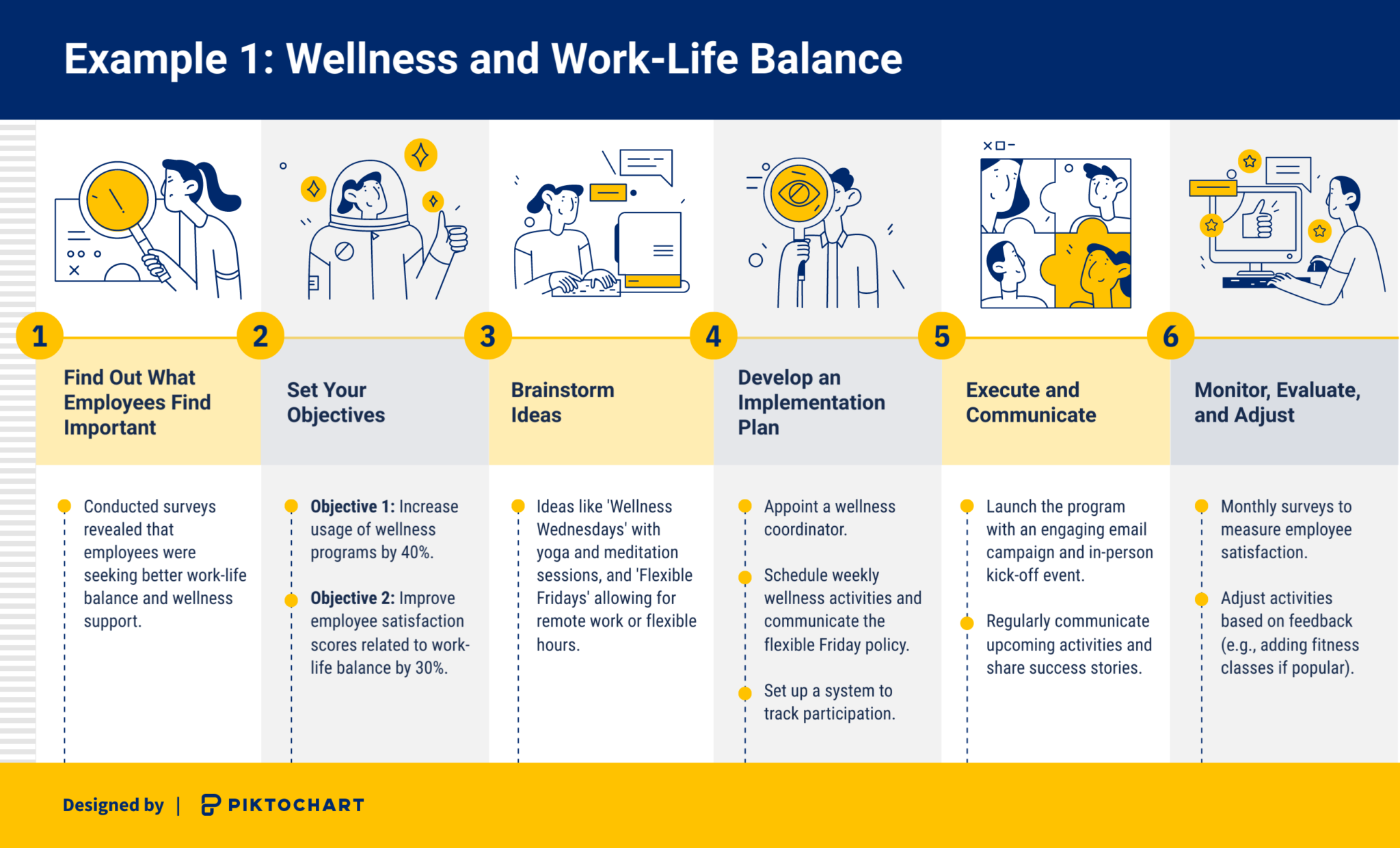
Example 2: Career Development and Mentorship Initiative
Step 1: Find Out What Employees Find Important
- Feedback indicated a strong desire for career growth opportunities and mentorship.
Step 2: Set Your Objectives
- Objective: Launch a mentorship program with at least 50% employee participation within six months.
Step 3: Brainstorm Ideas
- Pairing junior employees with senior mentors, and organizing quarterly career development workshops.
Step 4: Develop an Implementation Plan
- Identify mentors and set up a mentor-mentee matching process.
- Plan and schedule the first set of workshops.
Step 5: Execute and Communicate
- Officially announce the program through a mix of emails, posters, and a launch meeting.
- Regular updates on program progress and success stories.
Step 6: Monitor, Evaluate, and Adjust
- Collect feedback after each mentorship meeting and workshop.
- Make necessary adjustments to improve the program based on feedback.

Example 3: Team Engagement and Recognition Plan
Step 1: Find Out What Employees Find Important
- Employees expressed a desire for more recognition and team-building activities.
Step 2: Set Your Objectives
- Objective 1: Increase employee engagement scores by 25%.
- Objective 2: Host at least one team-building event per quarter.
Step 3: Brainstorm Ideas
- Monthly ‘Employee of the Month’ recognition, and quarterly team outings like a picnic or sports event.
Step 4: Develop an Implementation Plan
- Set criteria for employee recognition.
- Plan and schedule the first team-building event.
Step 5: Execute and Communicate
- Launch the recognition program with a company-wide announcement.
- Regularly update the team about upcoming events and recognized employees.
Step 6: Monitor, Evaluate, and Adjust
- Use feedback forms post-events to gather insights.
- Adjust the frequency and type of events or recognition methods based on employee feedback.

5 Tips to Create Your Own Engagement Plan
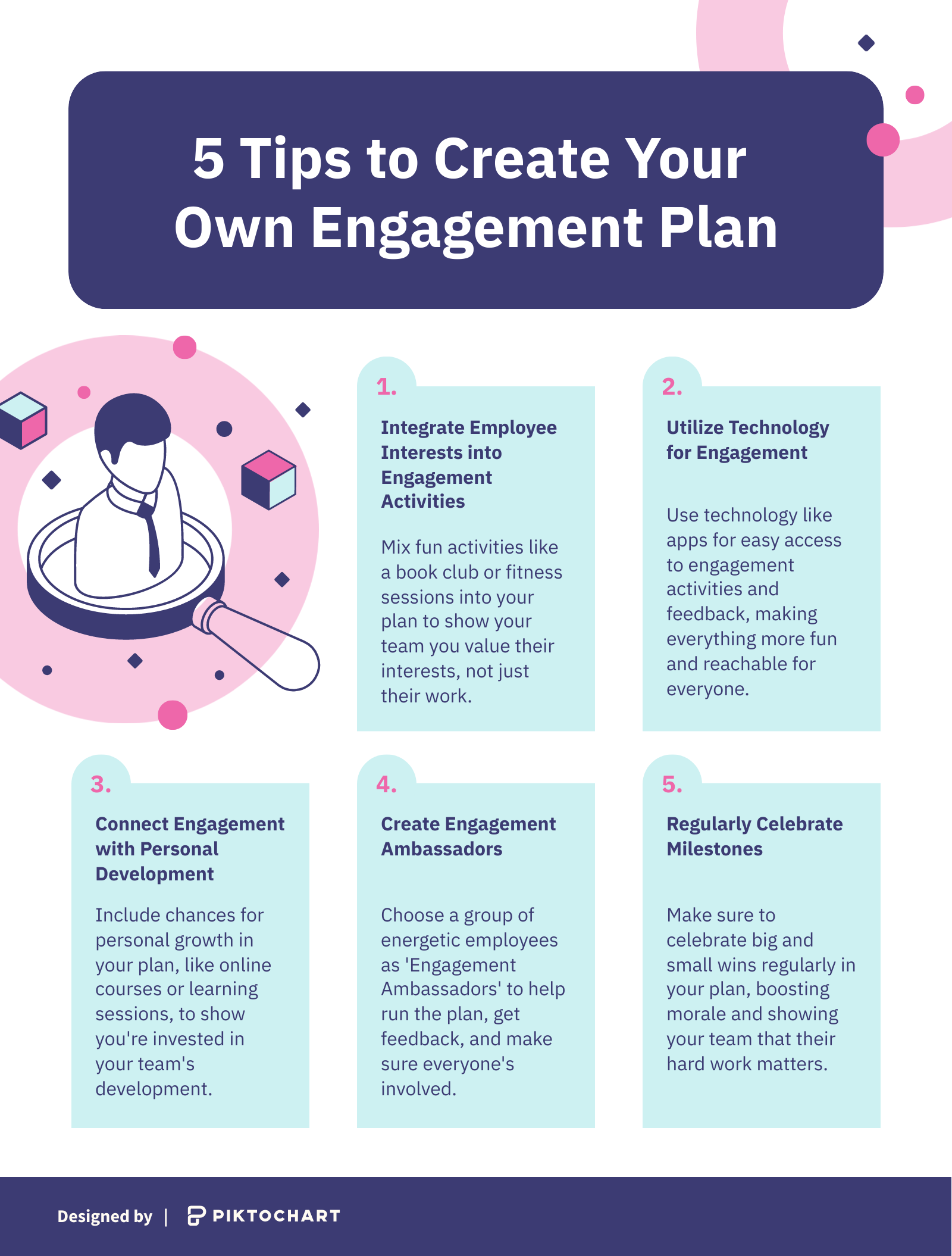
The examples above of employee engagement strategies look great, but what about your own employee engagement plan?
Your workplace is different, with its own way of doing things, challenges, and goals. A general plan won’t fit these perfectly. When you make your own plan, it matches what your company stands for, meets your team’s needs, and uses your team’s strengths.
You can also change your plan as you go, based on what your team says and how things are working.
Next, we’re going to give you the tools to build the best plan for your company. We have five key tips coming up.
Integrate Employee Interests into Engagement Activities
When designing your engagement plan, weave in activities that reflect your team’s hobbies and interests. Did your survey reveal a group of avid readers? Start a company book club. Or maybe you have fitness enthusiasts? Organize a weekly group workout.
By aligning activities with their interests, you show employees that you value their whole selves, not just their work selves. This personal touch can significantly boost engagement.
Utilize Technology for Engagement
In today’s digital world, technology can be a game-changer in how you implement your engagement plan. Use apps or platforms that allow employees to easily access engagement activities, give feedback, and recognize each other’s efforts.
For instance, a mobile app where employees can quickly participate in surveys, view upcoming events, or send a colleague a digital ‘thank you’ note. This makes engagement activities more accessible and fun.
Connect Engagement with Personal Development
A key aspect of engagement is personal growth. In your plan, include opportunities for employees to develop skills they’re passionate about, even if they’re not directly job-related. Perhaps offer an online course subscription or host lunch-and-learn sessions on diverse topics.
This approach demonstrates that you’re invested in their personal development, which can significantly increase engagement levels.
Create Engagement Ambassadors
Select a group of enthusiastic employees to be ‘Engagement Ambassadors.’ Their role is to help roll out the plan, gather informal feedback, and keep the energy high. They can be the go-to people for organizing events, communicating news, and ensuring everyone feels included.
Having peers who champion the plan can create a more authentic and engaging environment.
Regularly Celebrate Milestones
Make it a point in your plan to regularly celebrate company and individual milestones. It’s not just about big wins; small achievements matter too. Maybe it’s completing a project, reaching a service anniversary, or hitting a team goal.
Acknowledge these moments in team meetings or through company communication channels. Celebrating regularly keeps morale high and reminds everyone that their efforts are valued and contribute to the company’s success.
Final thoughts
Now, you’re all set to move your company forward with a team that’s enthusiastic about your goals and aligned with your vision. A well-crafted employee engagement plan isn’t just a tool for improvement; it’s a catalyst for transformation. It can revolutionize your workplace and propel your company to new heights.
To bring your engagement plan to life visually and make it more engaging, why not use infographics? They’re a fantastic way to simplify complex ideas and make information more captivating.
We recommend signing up for a free Piktochart account to start creating infographics that can enhance your engagement plan. It’s an easy and effective way to communicate your vision and keep everyone on the same page.
Embrace these steps, use the available templates, and watch as your workplace transforms into a hub of inspiration and outstanding performance. Your journey to a more engaged and thriving workforce starts now!
Frequently Asked Questions
How Can Organizations Ensure That the Employee Engagement Plan Remains Relevant and Adaptable to Unforeseen Changes in the Workplace Environment?
You should regularly review your engagement plan, seeking feedback from employees, and be ready to pivot strategies in response to new challenges or changes in the workplace environment.
What Specific Role Should Leadership Play in the Implementation and Ongoing Support of an Employee Engagement Plan?
You should champion the employee engagement plan, actively support initiatives, and model engagement behaviors. It’s vital you communicate openly and ensure the plan adapts to meet evolving employee and organizational needs.
How Can an Employee Engagement Plan Cater to the Diverse Needs and Expectations of a Multigenerational Workforce?
You’ll need to incorporate flexible strategies in your employee engagement plan to meet the varied needs of a multigenerational workforce, from traditionalists to Generation Z.
In What Ways Can Technology Be Leveraged to Enhance the Effectiveness of an Employee Engagement Plan?
You can leverage technology by implementing digital feedback tools, utilizing communication platforms, and analyzing engagement data to tailor and improve your engagement strategies effectively.
How Can an Organization Identify and Address Potential Resistance to the Employee Engagement Plan From Employees or Managers?
You’ll identify resistance by seeking feedback through surveys or meetings. Address concerns by involving employees in the planning process, ensuring transparency, and clearly communicating the plan’s benefits to both staff and management.
Elevate workplace satisfaction and performance
Ignite productivity with our dynamic employee engagement templates.
Begin today!